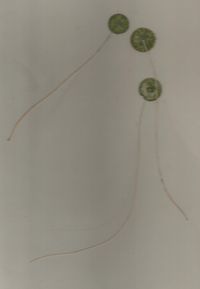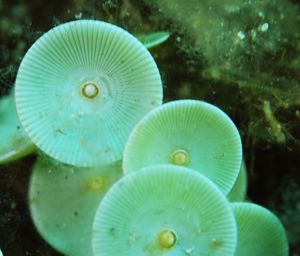أسيتابيولاريا
أسيتابيولاريا Acetabularia ، هو جنس من الطحالب الخضراءيعيش في المناطق الإستوائية وتحت الإستوائية ، ويوجد في البحر الأبيض المتوسط ولهذا الطحلب أهمية كبيرة في الأبحاث الخاصة بعلاقة النواة والسيتوبلازم بتركيب وحياة الكائن الحي . قالب:كتاب المملكة النباتية
| Acetabularia | |
|---|---|

| |
| التصنيف العلمي | |
| Domain: | |
| مملكة: | |
| Division: | |
| Class: | |
| Order: | |
| Family: | |
| Genus: | Acetabularia Lamouroux, 1812[1]
|
| Species | |
| |
. . . . . . . . . . . . . . . . . . . . . . . . . . . . . . . . . . . . . . . . . . . . . . . . . . . . . . . . . . . . . . . . . . . . . . . . . . . . . . . . . . . . . . . . . . . . . . . . . . . . . . . . . . . . . . . . . . . . . . . . . . . . . . . . . . . . . . . . . . . . . . . . . . . . . . . . . . . . . . . . . . . . . . . .
الوصف
يتكون طحلب أسيتابيولاريا عند النضج من ساق قائمة غير متفرعة قد يصل طولها إلى 10 سم وهي تحمل شعور عقيمة تسقط عند النضج . وتحمل في قمتها مظلة قد يصل قطرها إلى واحد سنتيمتر ، ويترسب عليها مركبات كلسية ، يثبت الطحلب في اليابسة بأشباه جذور .
تتكون المظلة من قرص خصب fertlile disc أو أكثر وقد يوجد أعلى المظلة شعور عقيمة ، ويتكون كل قرص من عدة أكياس جاميطية موجودة على هيئة أشعة gametangial rays متلاصقة جانبيا ، أو منفصلة تبعا للنوع (شكل 15 ب) .
التشريح ودورة الحياة
بعد إنبات الزيجوت وخلال الفترة الأولى من نمو الطحلب نلاحظ أنه يتكون من خلية واحدة ، تحتوي على نواة واحدة تبقى بالقرب من القاعدة وتستمر كذلك حتى يصل القرص الخصب إلى حجمه الكامل ، وأثناء ذلك تستطيل النواة لدرجة كبيرة . ثم تنقسم النواة عدة انقسامات وتتكون أنوية عددية تصل إلى عدة آلاف تحمل بواسطة الحركة الإنسيابية للسيتوبلازم ، إلى أعلى الثالوس ، وتهاج معظم الأنوية إلى أشعة الأكياس الجاميطية .ينقسم بروتوبلاست كل كيس جاميطي إلى أجزاء بكل منها نواة واحدة ، ثم يستدير كل جزء ، ويفرز جدار له غطاء محدد مكونا حوصلة cyst . تكبر الحوصلات في الحجم ، وتنقسم أنويتها عدة انقسامات غير مباشرة ، تسقط الحوصلات في الماء ، ثم تنقسم كل من أنويتها انقساما اختزاليا لتتكون الجاميطات الكمثرية الشكل المتحركة الثنائية الأسواط . تتحرر الجاميطات عن طريق غطاء الحوصلة الذي ينفتح لتخرج الجاميطات المتماثلة التي تتزاوج لتكون الزيجونات .
التشكل
التدرجات الكيميائية الداخلية
Circadian rhythms
المصادر
- ^ Lamouroux JVF (1812). "Extrait d'un mémoire sur la classification des Polypiers coralligènes non entièrement pierreux". Nouveaux Bulletin des Sciences, par la Société Philomathique de Paris. 3: 181–188.
قراءات إضافية
- Serio, D., Alongi, G., Catra, M., Cormaci, M. & Furnari, G. (2006). Changes in the benthic algal flora of Linosa Island (Straits of Sicily, Mediterranean Sea). Botanica Marina 49: 135-144.
- Berger, S. & Liddle. L.B. (2003). The life cycle of Acetabularia (Dasycladales, Chlorophyta): textbook accounts are wrong (Commentary). Phycologia 42(2): 204-207, 3 figs.
- Berger, S., Fettweiss, U., Gleissberg, S., Liddle, L.B., Richter, U., Sawitsky, H. & Zuccarello, G.C. (2003). 18S rDNA phylogeny and evaluation of cap development in Polyphysaceae (formerly Acetabulariaceae; Dasyladales, Chlorophyta). Phycologia 42: 506-561.
- Bonotto S (1994). "Developmental biology of Acetabularia". J. Mar. Biol. Ass. U.K. 74: 93–106. doi:10.1017/S0025315400035694.
- Berger S, de Groot E, Heuhaus G, Schweiger M (1987). "Acetabularia: a giant single cell organism with valuable advantages for cell biology". European Journal of Cell Biology. 44: 349–370.
{{cite journal}}: CS1 maint: multiple names: authors list (link)
- Puiseux-Dao S (1970). Acetabularia and Cell Biology. New York: Springer Verlag. ISBN 0236177389.
- Schweiger H? (1969). "Cell biology of Acetabularia". Current Topics in Microbiology and Immunology. 50: 1–36.
مراجع متنوعة
- Cinelli, F. (1979). Acetabularia acetabulum (L.) Silva, Acetabularia parvula Solms-Laubach and Dasycladus vermicularis (Scopoli) Krasser (Chlorophyta, Dasycladales): ecology and distribution in the Mediterranean Sea.. In: Developmental Biology of Acetabularia. (Bonotto, S., Kefeli, V. & Puiseux-Dao, S. Eds), pp. 3–14. Amsterdam: Elsevier North Holland Biomedical Press.
- Cooper, J.J. & Mandoli, D.F. (1999). Physiological factors that aid differentiation of zygotes and early juveniles of Acetabularia acetabulum (Chlorophyta). Journal of Phycology 35: 143-151, 9 figs.
- Dazy, A. C., Borghi, H., Durand, M. & Puiseux-Dao, S. (1984). The effects of blue and red light on the transcellular electric potential, cytoplasmic streaming and rRNA transport in Acetabularia acetabulum. Proceedings of the International Seaweed Symposium 11: 193-197.
- Hunt, B.E. & Mandoli, D.F. (1996). A new, artificial seawater that facilitates growth of large numbers of cells of Acetabularia acetabulum (Chlorophyta) and reduces the labor inherent in cell culture. Journal of Phycology 32: 483-495, 6 figs, 3 tables.
- Kingsley, R.J., Van Gilder, R., LeGeros, R.Z. & Watabe, N. (2003). Multimineral calcareous deposits in the marine alga Acetabularia acetabulum (Chlorophyta; Dasycladaceae). Journal of Phycology 39: 937-947.
- Kratz, R.F., Young, P.A. & Mandoli, D.F. (1998). Timing and light regulation of apical morphogenesis during reproductive development in wild-type populations of Acetabularia acetabulum (Chlorophyceae). Journal of Phycology 34: 138-146, 6 figs, 2 tables.
- Lüttke, A. (1988). The lack of chloroplast DNA in Acetabularia mediterranea (acetabulum) (Chlorophyceae): A reinvestigation. Journal of Phycology 24: 173-180, 12 figs.
- Mandoli, D.F., Wexler, A., Teschmacher, J. & Zukowski, A. (1995). Note: Brief incubation of gametangia-bearing caps in antibiotics eliminates branching in progeny of Acetabularia acetabulum (Chlorophyta). Journal of Phycology 31: 844-848, 4 figs, 3 tables.
- Menzel, D. (1981). Development and fine structure of plugs in the cap rays of Acetabularia acetabulum (mediterranea) (L.) Silva (Dasycladales). Phycologia 20: 56-64, 21 figs.
- Nishimura, N.J. & Mandoli, D.F. (1992). Population analysis of reproductive cell structures of Acetabularia acetabulum (Chlorophyta). Phycologia 31: 351-358, 9 figs, 2 tables.
- Nishimura, N.J. & Mandoli, D.F. (1992). Vegetative growth of Acetabularia acetabulum (Chlorophyta): structural evidence for juvenile and adult phases in development. Journal of Phycology 28: 669-677, 7 figs.
- Zeller, A. & Mandoli, D.F. (1993). Growth of Acetabularia acetabulum (Dasycladales, Chlorophyta) on solid substrata at specific cell densities. Phycologia 32: 136-142
روابط خارجية
- www.accessexcellence.org
- Berger, Sigrid (2006).- Photo-Atlas of living Dasycladales.- ISBN 2-916733-01-9, Carnets de Géologie, Brest, Book / Livre 2006/02 (CG2006_BOOK_02), 348 p., 1 fig., 332 micrographs.
- UTEX culture collection of algae, at the University of Texas at Austin
- CCAP: Culture Collections of Algae and Protozoa
